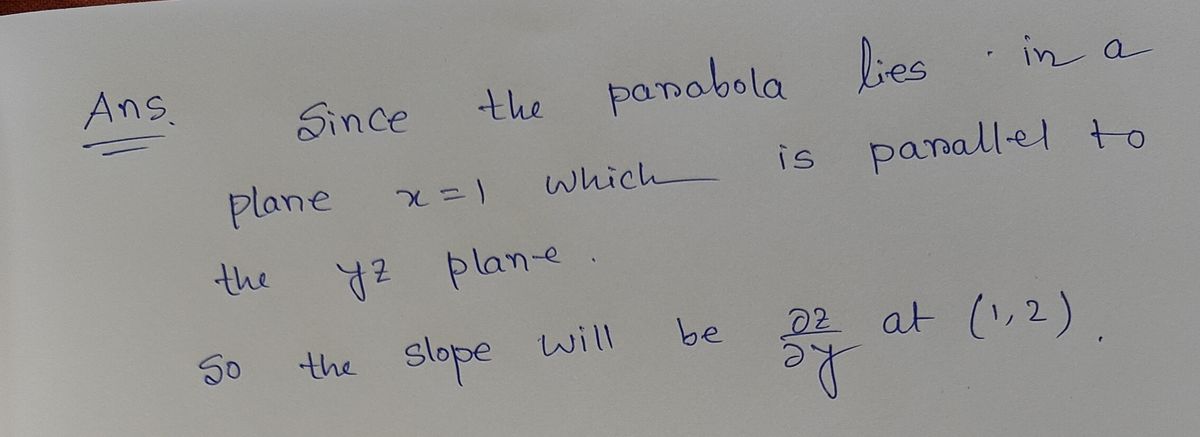Calculus 3 Partial Derivatives. Question 1: Read Example 5 (p. 827). Based on the question, how can you tell which partial derivative should be used for the solution? Explain how this connects with your answer from Partial Derivatives of a Function of Two Variables.
Calculus 3 Partial Derivatives. Question 1: Read Example 5 (p. 827). Based on the question, how can you tell which partial derivative should be used for the solution? Explain how this connects with your answer from Partial Derivatives of a Function of Two Variables.
Advanced Engineering Mathematics
10th Edition
ISBN:9780470458365
Author:Erwin Kreyszig
Publisher:Erwin Kreyszig
Chapter2: Second-order Linear Odes
Section: Chapter Questions
Problem 1RQ
Related questions
Question
Calculus 3 Partial Derivatives.
Question 1: Read Example 5 (p. 827). Based on the question, how can you tell which partial
derivative should be used for the solution? Explain how this connects with your answer from Partial Derivatives of a Function of Two Variables.

Transcribed Image Text:Chapter 14 Partial Derivatives
EXAMPLE 4 Find az/ax assuming that the equation
yz - In z = x + y
defines z as a function of the two independent variables x and y and the partial derivative
exists.
Solution We differentiate both sides of the equation with respect to x, holding y constant
and treating z as a differentiable function of .x:
a
ax(xz)-ax In z = +
az
y ax
y-
1 az
z ax
ax dy
ax
ax ax
= 1 + 0
14.3 Partial Derivatives 827
= 1
yz
With y constant,
ax
(32) =
818
![Plane
x=1
(1, 2, 5)
Surface
Tangent
line
FIGURE 14.19 The tangent to the curve
of intersection of the plane x-1 and
surface z = x² + y² at the point (1, 2, 5)
(Example 5).
EXAMPLE 5 The plane x = 1 intersects the paraboloid z = x² + y² in a parabola.
Find the slope of the tangent to the parabola at (1, 2, 5) (Figure 14.19).
Solution The parabola lies in a plane parallel to the yz-plane, and the slope is the value
of the partial derivative az/ay at (1, 2):
-(x²³ ² + y²)
= 2y
(1.2)
(1.2)
(1,2)
As a check, we can treat the parabola as the graph of the single-variable function
z = (1)² + y² = 1 + y² in the plane x = 1 and ask for the slope at y = 2. The slope,
calculated now as an ordinary derivative, is
EXAMPLE 6
Functions of More Than Two Variables
The definitions of the partial derivatives of functions of more than two independent vari-
ables are similar to the definitions for functions of two variables. They are ordinary deriva-
tives with respect to one variable, taken while the other independent variables are held
constant.
then
af
dz
= 2(2) = 4.
-
$12-
- - ²5 - 4
d (1 + y²)
(²)| 1-²
2y
y-2
If x, y, and z are independent variables and
f(x, y, z)=xsin (y + 32),
ə
[x sin (y + 3z)] = xsin (y + 3z)
= x cos (y + 32) (y + 32)
= 3x cos (y + 3z).
x held constant
Chain rule
y held constant](/v2/_next/image?url=https%3A%2F%2Fcontent.bartleby.com%2Fqna-images%2Fquestion%2Ffd35cf2d-d59c-46d2-9acb-f7bd2544420e%2F308fb931-bca2-4071-9e88-1fc872473dc3%2F1xmthkl_processed.png&w=3840&q=75)
Transcribed Image Text:Plane
x=1
(1, 2, 5)
Surface
Tangent
line
FIGURE 14.19 The tangent to the curve
of intersection of the plane x-1 and
surface z = x² + y² at the point (1, 2, 5)
(Example 5).
EXAMPLE 5 The plane x = 1 intersects the paraboloid z = x² + y² in a parabola.
Find the slope of the tangent to the parabola at (1, 2, 5) (Figure 14.19).
Solution The parabola lies in a plane parallel to the yz-plane, and the slope is the value
of the partial derivative az/ay at (1, 2):
-(x²³ ² + y²)
= 2y
(1.2)
(1.2)
(1,2)
As a check, we can treat the parabola as the graph of the single-variable function
z = (1)² + y² = 1 + y² in the plane x = 1 and ask for the slope at y = 2. The slope,
calculated now as an ordinary derivative, is
EXAMPLE 6
Functions of More Than Two Variables
The definitions of the partial derivatives of functions of more than two independent vari-
ables are similar to the definitions for functions of two variables. They are ordinary deriva-
tives with respect to one variable, taken while the other independent variables are held
constant.
then
af
dz
= 2(2) = 4.
-
$12-
- - ²5 - 4
d (1 + y²)
(²)| 1-²
2y
y-2
If x, y, and z are independent variables and
f(x, y, z)=xsin (y + 32),
ə
[x sin (y + 3z)] = xsin (y + 3z)
= x cos (y + 32) (y + 32)
= 3x cos (y + 3z).
x held constant
Chain rule
y held constant
Expert Solution
Step 1: Here

Step by step
Solved in 3 steps with 3 images

Recommended textbooks for you

Advanced Engineering Mathematics
Advanced Math
ISBN:
9780470458365
Author:
Erwin Kreyszig
Publisher:
Wiley, John & Sons, Incorporated

Numerical Methods for Engineers
Advanced Math
ISBN:
9780073397924
Author:
Steven C. Chapra Dr., Raymond P. Canale
Publisher:
McGraw-Hill Education

Introductory Mathematics for Engineering Applicat…
Advanced Math
ISBN:
9781118141809
Author:
Nathan Klingbeil
Publisher:
WILEY

Advanced Engineering Mathematics
Advanced Math
ISBN:
9780470458365
Author:
Erwin Kreyszig
Publisher:
Wiley, John & Sons, Incorporated

Numerical Methods for Engineers
Advanced Math
ISBN:
9780073397924
Author:
Steven C. Chapra Dr., Raymond P. Canale
Publisher:
McGraw-Hill Education

Introductory Mathematics for Engineering Applicat…
Advanced Math
ISBN:
9781118141809
Author:
Nathan Klingbeil
Publisher:
WILEY

Mathematics For Machine Technology
Advanced Math
ISBN:
9781337798310
Author:
Peterson, John.
Publisher:
Cengage Learning,

